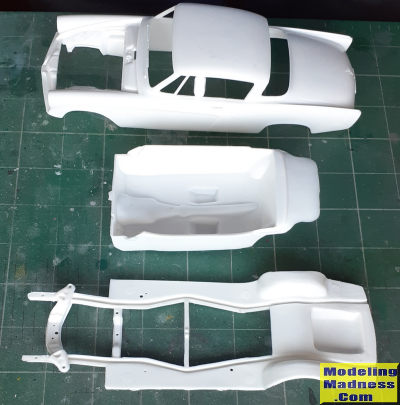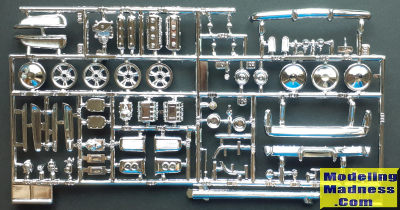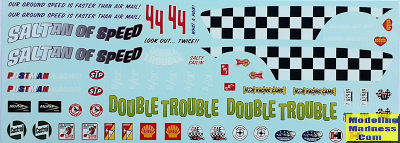
| KIT #: | A-1251 |
| PRICE: | $25.00 |
| DECALS: | One option |
| REVIEWER: | John Summerford |
| NOTES: | Can build one of three versions |

| HISTORY |
Courtesy of Classic Driver
Studebakers boasted spectacular styling for 1953 courtesy of designer Bob Bourke of the Raymond Loewy studio based in Studebaker’s hometown of South Bend, Indiana. The dramatically sleek car, inspired by the Lockheed Constellation, was astoundingly low by 1953 standards at just 56.3 inches high while accentuated by a long 120.5 wheelbase. The drive train was a 232-cid, 120-hp V-8 and automatic transmission. What should have been a magnificent sales year for Studebaker, turned out to be a rather ho-hum one at-best. Studebaker focused more on sedans rather than coupes, and production ills developed as front-end sheet metal failed to fit the coupe body at first. Demand for the new coupes outpaced sedans four-to-one catching Studebaker product planners off-guard while a strike at the Borg Warner plant curtailed availability of automatic transmissions. The car received numerous design awards and today serves as a landmark of modern design. 19,236 Commander Starliner Coupes were produced for the model year of a total 151,576 Studebakers; fewer than the 1952 model year, dropping the company to tenth in industry sales.
| THE KIT |
 Frequent readers may suspect that
I’m not much of a car guy, so it took some packaging to get my attention. While
cruising the website of my (nearly) LHS, the photo of the lid to this tin box
and the headline caught my attention. Readers may also suspect that I gravitate
to more unusual subjects, so when the package appeared on my doorstep, I quickly
tore into the box.
Frequent readers may suspect that
I’m not much of a car guy, so it took some packaging to get my attention. While
cruising the website of my (nearly) LHS, the photo of the lid to this tin box
and the headline caught my attention. Readers may also suspect that I gravitate
to more unusual subjects, so when the package appeared on my doorstep, I quickly
tore into the box.
 My first observation was that the
parts are nicely packed into 12 bags. The second observation was that this is
very much a late-60s-early-70s mold. No flash is present on my example, but
there are heavy seamlines to clean up. Round 2 proudly notes in the preamble to
the instructions that the sprue gates on the chromed pieces are on the back side
of the parts. It looks to me that many of the seams are also strategically
located.
My first observation was that the
parts are nicely packed into 12 bags. The second observation was that this is
very much a late-60s-early-70s mold. No flash is present on my example, but
there are heavy seamlines to clean up. Round 2 proudly notes in the preamble to
the instructions that the sprue gates on the chromed pieces are on the back side
of the parts. It looks to me that many of the seams are also strategically
located.
The total parts count is 113, but which parts are used depends of which version one chooses to build--stock, custom, or racer. The custom version will require some surgery to lower the roof. It, and the racer, use the tinted window parts.
 The first step calls for building
the engine, either standard or racer. Spark plug wires are not supplied. The
next two steps concern the chassis-wheels, then the interior. The instructions
are clear as to which parts to use for which version. A metal axle is provided
for the rear wheels and a complete suspension is built up for the front wheels
and should be able to posed in a turn. There are no decals for the dashboard.
Color notes are generic, indicating paints such as “steel”, “black”, or
“interior color”. What interior, or exterior, color to use is left up to the
imagination. Step four is the body assembly and the final step is about external
details that depend on the chosen version.
The first step calls for building
the engine, either standard or racer. Spark plug wires are not supplied. The
next two steps concern the chassis-wheels, then the interior. The instructions
are clear as to which parts to use for which version. A metal axle is provided
for the rear wheels and a complete suspension is built up for the front wheels
and should be able to posed in a turn. There are no decals for the dashboard.
Color notes are generic, indicating paints such as “steel”, “black”, or
“interior color”. What interior, or exterior, color to use is left up to the
imagination. Step four is the body assembly and the final step is about external
details that depend on the chosen version.
| CONCLUSIONS |
The box lid depicts the stock version, while on one long-side shows a custom car and the other side the racer. I spent about half-an-hour on the internet looking at different painting options. The only factory paint scheme that I could verify is that depicted on the lid--red body and white roof. Possibly, another factory scheme is teal body and pale green roof. My example’s body could use some polishing before priming. I suspect that files and patience will be needed to get parts to fit well. I’m sure that car modelers will find that this is a typical kit. The end result should be a sleek looking car.
November 2021
Copyright ModelingMadness.com. All rights reserved. No
reproduction in part or in whole without express permission.
If you would like your product reviewed fairly and fairly quickly, please
contact
the editor or see other details in the
Note to
Contributors.